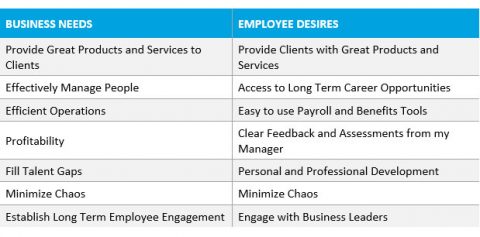Employee Engagement – The True Value of HCM Technology
by Chris Bond | March 9, 2018 12:59 PM | Shark Bites - Ultimate Edition

On a recent trip to our offices in Europe, a Client posed a rather interesting question. “Is there real value for our company in a Full Suite HCM system”? We began to discuss multiple potential benefits including the impact of lowering the IT footprint for his organization, the value of collecting data all in one location, and having a single location for employees to find information.
While he agreed that those are all good benefits, he was still searching for something more. He felt that typical IT systems always received the bulk of attention and funding. He wanted something to differentiate a Full Suite HCM system from the typical collection of various IT systems for HR.
Is there a more compelling argument that can move the needle?
I had an opportunity to consider this question with 20 hours of travel from Munich to Dallas. I knew I had to come up with an answer if I was going to get any sleep on the trip home. My mind went to work, but nothing. I couldn’t think of a more compelling argument than I had already given. Frustrated, I put the idea aside and focused on my weekend ahead. While walking in the woods with my wife in Wimberley, Texas over the weekend it hit me. Employee Engagement.
Human Capital Management (HCM) is THE key to enabling Employee Engagement in any organization. Why do we care about Employee Engagement? A recent ADP study reveals that 5% of workers leave their jobs every month. That’s a 60% voluntary turnover rate per year. Staggering. One of the key metrics from our Bluewater studies shows that Employee Engagement (or lack thereof) is the number one reason for departure from a job.
Engaged employees are, according to Gallup, employees that are involved in, enthusiastic about, and committed to their work. There is a well-established connection between employee engagement and: customer ratings, profitability, productivity, turnover, safety incidents, theft, absenteeism, patient safety incidents, and quality. The results are in: engaged employees deliver positive business outcomes. By minimizing negative behaviors and amplifying positive behaviors, engaged employees help create a virtuous cycle that consistently delivers favorable results.
As an industry, we are always looking for the next great tool to drive Employee Engagement. Attend the HR Tech conference and every year you will find 20 new Employee Engagement tools ready to solve your next big problem. How much of the Employee Engagement problem does any software tool solve and do I need a different tool for each problem?
The reality is software tools only solve a small part of the problem. Plus, most companies already have in their existing HCM software the tools they need to make a huge improvement in Employee Engagement. Your employees already engage with your existing HCM tools on a daily basis. The key question is this:
Are you using your existing HCM tools in a way that is transformational?
For most companies, the answer is no. They have the tools they need but are not using them in a way that is transformational. Most companies use their HCM tools the way most individuals use Microsoft Word. They only use a small fraction of the power and capability of the software.
Think about it. If we can truly engage Employees and help them to feel a part of the business and a part of the process then we have taken a major step in solving three big issues within our organizations.
- Reducing the voluntary turnover of good people
- Increasing the quality of products delivered
- Increasing client satisfaction because happy employees breed happy clients
Before we go any further, let’s look at a few concepts and make sure we are on the same page.
HCM Technology includes the following applications:
What is it that we are trying to do with these tools? Engage our employees. Unfortunately, the transformation possibilities that exist between these applications are lost because most organizations still operate in silos. Even within our HR departments, we operate in silos. Trust me, we have worked with hundreds of companies over the years and I can tell you point-blank. Silos are not just a big company problem. They are a problem for all organizations. Consider these questions:
- Are you using each of the HCM applications listed above independently?
- How tightly are your processes integrated between any individual application and the remaining applications?
- Are there any two applications that are completely unrelated? If so, which ones?
- Are you using each of these technologies as one ecosystem?
- Do your employees have one common user experience when engaging with each of these mission-critical activities or do they have to navigate to multiple places to do things that should be simple?
The second concept I want to introduce is the HCM Ecosystem. Our reality is that one system will not solve all these problems. We must have an Ecosystem of technologies to Engage our Employees. Yet the Ecosystem cannot just be about technology. Our HCM Ecosystem must engage People, Processes, and Technology. (Look for another blog post in the near future on the value of an HCM Ecosystem).
The goal is true Employee Engagement, which produces a bottom-line benefit to the company and the Employee. What is the real business problem we are trying to solve and can we solve it using HCM technology? I believe it’s an age-old problem we are attempting to solve. It is the issue of balancing the needs of the business against the desires of the employee. The weight of the scales moves one direction or the other way too often. This year let's plan on taking care of the employee. Next year let's focus on the needs of the business. Most organizations are without a strategy for this most important concept. For companies to reach their maximum potential there must be an equal balance between taking care of the needs of the Business and the desires of the Employee.
What are the typical business needs and employee desires:

Balance can be achieved through Employee Engagement. Employee Engagement can be achieved through an HCM Ecosystem. Reality check here. Employee Engagement must be a people-to-people process. What we are really talking about is technology to enable that engagement. In order to enable this type of Employee Engagement, we must be able to provide tools to Employees, Managers, and Executives. The tools are systems and processes made easier by the use of HCM Technology.
Everything you see in the list above is already happening today. The question is how well?
Consider the following scenario, which I would like to see in my own business, as a vision of the engagement of an employee through process and technology.
Example employee engagement model:
Back to the initial question posed by my Client and Friend. What is the true value of HCM? I am more confident today than ever that the future of our engagement with employees must rely on the use of HCM tools and processes. If we are to employ and develop the workforce of today and the future, we must engage them to eliminate chaos, focus on the value that we derive from each other, reward them when possible, and consistently provide opportunities to grow.
However, this all must start with the strategy. You must know what your plan is or your use of HCM technology will add to the chaos. Three things for you to consider as you approach your HCM strategy:
- How do my Employee Engagement needs match the drivers of my business?
- Is my organization ready to engage employees by building a new process that utilizes HCM technology?
- If the answer to question #2 is no, then how are you going to engage, develop and promote employees for the future of your business?
As we use tools and technologies with our Clients and within Bluewater, I will share more about successful and less-than-successful outcomes. Either way, we learn together and improve the outcomes for our businesses and our teams of people who rely on us to engage them in the future of our business.
Looking for an Employee Engagement solution? Chances are you already have the tools to make this work. Contact us today and let's discuss solutions.
Search Our Blogs
Categories
- Ad Hoc (1)
- ADMIN (1)
- administration (1)
- AI (2)
- analytics (2)
- anxiety (1)
- Artificial intelligence (2)
- automation (1)
- BI (1)
- blog (1)
- Blueprint (1)
- center of excellence (10)
- Communication (2)
- COVID-19 (2)
- Culture (1)
- Custom Content (1)
- customer service (1)
- Data (1)
- Employee Engagement (1)
- Shark Bites - Cornerstone Edition (12)
- Shark Bites - SumTotal Edition (4)
- Shark Bites - Ultimate Edition (5)
- The Future of Learning (16)
- The Future of Talent Management (30)
- User Experience (2)
- UX (2)
- wellbeing (1)
Recent Posts
- Selecting Learning & Talent Technology - Part 5: Evaluating Vendors and Solutions
- Selecting Learning & Talent Technology - Part 4: Defining Technology Requirements
- Selecting Learning & Talent Technology - Part 3: Assessing and Aligning Talent Needs
- Selecting Learning & Talent Technology - Part 2: Understanding Business Drivers
- Selecting Learning & Talent Technology: A Strategic Approach to Success



